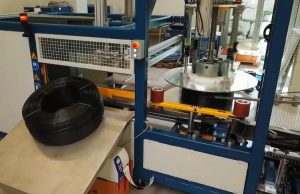Enhancing Efficiency: Understanding Automatic Hose and Pipe Coiling & Binding Machines
Handling hoses and pipes, especially in manufacturing and distribution settings, can be cumbersome and time-consuming. Ensuring they are neatly coiled and securely bound is crucial for efficient storage, transport, and deployment. Automatic hose and pipe coiling and binding machines offer a streamlined solution to this challenge. This guide explores the function, features, and benefits of these essential pieces of industrial equipment.
1. What is an Automatic Hose and Pipe Coiling and Binding Machine?
An automatic hose and pipe coiling and binding machine is specialized industrial machinery designed to automate the process of winding hoses or pipes into coils of predetermined lengths and securing them with binding material (like strapping or tape). This eliminates manual labor, improves consistency, and speeds up the packaging process significantly. The machine featured in the video is specifically configured for handling shorter length pipe coils.
2. How Does the Coiling and Binding Process Work?
While designs vary, the typical operational sequence involves several automated steps:
- Infeed: The hose or pipe material is fed into the machine, often via an automated conveyor or feeding system.
- Measuring: A measuring device accurately determines the required length for the coil (e.g., 5-15 meters as specified for the machine type).
- Coiling: The material is wound around a coiling head or mandrel to form a neat, uniform coil. The machine controls the tension and winding pattern.
- Cutting: Once the desired length is reached, an integrated cutting mechanism cleanly severs the hose or pipe.
- Binding: The machine automatically applies binding material (often plastic strapping or tape) at specified points around the coil to secure it. The example machine uses two binding lines per coil.
- Ejection: The finished, bound coil is ejected from the machine, ready for storage or further packaging.
3. Key Specifications and Parameters (Example Machine)
Based on the initial information provided, this specific type of machine operates within these parameters:
- Product Type: Hose, Pipe
- Length Capacity: 5-15 meters per coil
- Binding Method: 2 lines of binding material per coil
- Coiling Cycle Speed: Approximately 4-8 seconds per coil (excluding material feeding time)
4. Core Features and Components of Automated Coiling Systems

Modern automatic hose and pipe coiling and binding machines often incorporate several key features:
4.1. Automated In-feed System
Ensures a continuous and smooth supply of hose or pipe material into the machine, maximizing throughput.
4.2. Precision Coiling Mechanism
Utilizes servo motors or precisely controlled drives to create consistent coil diameters and winding patterns.
4.3. Integrated Binding Unit
Automatically applies and secures the binding material, ensuring coils remain tightly wound during handling and transport.
4.4. Adjustable Parameter Controls
Allows operators to easily set and modify parameters like coil length, coil diameter, binding positions, and operating speed via a user interface (e.g., HMI touchscreen).
4.5. Robust Construction and Safety Features
Built with durable materials for longevity in industrial environments. Includes safety interlocks, guarding, and emergency stops to protect operators.
5. Benefits of Using Automated Coiling and Binding
Integrating these machines into a production or distribution line offers substantial advantages:
5.1. Increased Productivity and Throughput
Automated cycles are significantly faster (4-8 seconds per coil in this example) than manual methods, boosting overall output.
5.2. Improved Consistency and Quality
Machines produce uniform coils with consistent length, diameter, and binding placement, leading to professional and predictable packaging.
5.3. Enhanced Worker Safety
Reduces manual handling of potentially heavy or unwieldy materials, minimizing risks of strains, sprains, and repetitive motion injuries.
5.4. Optimized Material Handling and Storage
Neatly coiled and bound products are easier to stack, store, and transport, optimizing warehouse space and logistics.
5.5. Reduced Labor Costs
Automation decreases the need for manual labor dedicated to the coiling and binding tasks, allowing personnel to be reassigned to higher-value activities.
6. Common Applications in Industry
These machines are valuable across various sectors, including:
- Hose and pipe manufacturing facilities
- Plumbing and irrigation supply distributors
- Automotive component production
- Telecommunications cable packaging
- Electrical wire and conduit handling
- Agricultural tubing production
7. Considerations When Selecting a Machine
Choosing the right machine involves evaluating:
- Material Type and Size: Compatibility with the specific hoses/pipes (diameter, rigidity, material).
- Production Volume: Required throughput (coils per hour/day).
- Coil Specifications: Desired length range, diameter, and binding requirements.
- Available Space: Machine footprint and integration with existing lines.
- Budget: Initial investment versus long-term operational savings.

hose coiling machine Conclusion
Automatic hose and pipe coiling and binding machines are pivotal in modernizing packaging operations. By automating a labor-intensive process, they deliver significant improvements in speed, consistency, safety, and cost-efficiency. Understanding their operation, features, and benefits is key for industries looking to optimize their handling of hoses, pipes, and similar coiled products.
